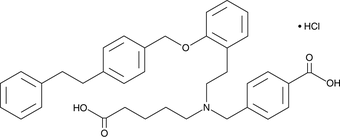Cayman
Showing 15451–15600 of 45550 results
-
Soluble guanylate cyclase (sGC) is the primary cellular receptor for NO. NO binds and activates a heme group in sGC, initiating the conversion of GTP to the second messenger cGMP. cGMP subsequently mediates a number of signaling cascades leading to vasorelaxation and inhibiting smooth muscle proliferation, leukocyte recruitment, and platelet aggregation. Oxidation of the heme results in its dissociation from sGC and an impairment of NO signaling, which has been linked to hypertension, hyperlidemia, cardiovascular disease, and diabetes.{26751} Cinaciguat is an activator of sGC that binds to a regulatory site, resulting in activation in an NO-independent manner (Kd = 3.2 nM).{29430} It activates the enzyme even if it has been oxidized or rendered heme deficient.{29430} In animals, cinaciguat has been shown to reduce hypertension, limit cardiomyocyte hypertrophy, protect against ischemia/reperfusion injury, and reduce morbidity and mortality in response to endotoxic shock.{29430,29428,29429,29431}
Brand:CaymanSKU:-Available on backorder
Soluble guanylate cyclase (sGC) is the primary cellular receptor for NO. NO binds and activates a heme group in sGC, initiating the conversion of GTP to the second messenger cGMP. cGMP subsequently mediates a number of signaling cascades leading to vasorelaxation and inhibiting smooth muscle proliferation, leukocyte recruitment, and platelet aggregation. Oxidation of the heme results in its dissociation from sGC and an impairment of NO signaling, which has been linked to hypertension, hyperlidemia, cardiovascular disease, and diabetes.{26751} Cinaciguat is an activator of sGC that binds to a regulatory site, resulting in activation in an NO-independent manner (Kd = 3.2 nM).{29430} It activates the enzyme even if it has been oxidized or rendered heme deficient.{29430} In animals, cinaciguat has been shown to reduce hypertension, limit cardiomyocyte hypertrophy, protect against ischemia/reperfusion injury, and reduce morbidity and mortality in response to endotoxic shock.{29430,29428,29429,29431}
Brand:CaymanSKU:-Available on backorder
Soluble guanylate cyclase (sGC) is the primary cellular receptor for NO. NO binds and activates a heme group in sGC, initiating the conversion of GTP to the second messenger cGMP. cGMP subsequently mediates a number of signaling cascades leading to vasorelaxation and inhibiting smooth muscle proliferation, leukocyte recruitment, and platelet aggregation. Oxidation of the heme results in its dissociation from sGC and an impairment of NO signaling, which has been linked to hypertension, hyperlidemia, cardiovascular disease, and diabetes.{26751} Cinaciguat is an activator of sGC that binds to a regulatory site, resulting in activation in an NO-independent manner (Kd = 3.2 nM).{29430} It activates the enzyme even if it has been oxidized or rendered heme deficient.{29430} In animals, cinaciguat has been shown to reduce hypertension, limit cardiomyocyte hypertrophy, protect against ischemia/reperfusion injury, and reduce morbidity and mortality in response to endotoxic shock.{29430,29428,29429,29431}
Brand:CaymanSKU:-Available on backorder
Soluble guanylate cyclase (sGC) is the primary cellular receptor for NO. NO binds and activates a heme group in sGC, initiating the conversion of GTP to the second messenger cGMP. cGMP subsequently mediates a number of signaling cascades leading to vasorelaxation and inhibiting smooth muscle proliferation, leukocyte recruitment, and platelet aggregation. Oxidation of the heme results in its dissociation from sGC and an impairment of NO signaling, which has been linked to hypertension, hyperlidemia, cardiovascular disease, and diabetes.{26751} Cinaciguat is an activator of sGC that binds to a regulatory site, resulting in activation in an NO-independent manner (Kd = 3.2 nM).{29430} It activates the enzyme even if it has been oxidized or rendered heme deficient.{29430} In animals, cinaciguat has been shown to reduce hypertension, limit cardiomyocyte hypertrophy, protect against ischemia/reperfusion injury, and reduce morbidity and mortality in response to endotoxic shock.{29430,29428,29429,29431}
Brand:CaymanSKU:-Available on backorder
Cinanserin is a serotonin (5-HT) receptor antagonist.{61112,61113} It inhibits 5-HT-induced effects on isolated rat uterus but not guinea pig ileum.{61112} Cinanserin inhibits 5-HT-induced gross excitation, gastric mucosal erosion, and anaphylactoid edema in mice and rats. Cinanserin (12 and 36 mg/kg, i.p.) impairs acquisition of a running response in rats trained for food reward.{61113} It inhibits severe acute respiratory syndrome coronavirus (SARS-CoV) 3C-like proteinase (3CLPro; IC50 = 5 µM) and reduces SARS-CoV viral RNA levels in infected BHK-Rep-1 cells (IC50s = 19-34 µM).{61114} It also inhibits viral replication of murine hepatitis virus (MHV) in CCL-9.1 murine liver epithelial cells (IC50 = 31.25 µg/ml).{32157}
Brand:CaymanSKU:30729 - 10 mgAvailable on backorder
Cinanserin is a serotonin (5-HT) receptor antagonist.{61112,61113} It inhibits 5-HT-induced effects on isolated rat uterus but not guinea pig ileum.{61112} Cinanserin inhibits 5-HT-induced gross excitation, gastric mucosal erosion, and anaphylactoid edema in mice and rats. Cinanserin (12 and 36 mg/kg, i.p.) impairs acquisition of a running response in rats trained for food reward.{61113} It inhibits severe acute respiratory syndrome coronavirus (SARS-CoV) 3C-like proteinase (3CLPro; IC50 = 5 µM) and reduces SARS-CoV viral RNA levels in infected BHK-Rep-1 cells (IC50s = 19-34 µM).{61114} It also inhibits viral replication of murine hepatitis virus (MHV) in CCL-9.1 murine liver epithelial cells (IC50 = 31.25 µg/ml).{32157}
Brand:CaymanSKU:30729 - 5 mgAvailable on backorder
Cinazepam (Item No. 30208) is an analytical reference standard categorized as a benzodiazepine.{52356} Cinazepam is a prodrug form of 3-hydroxy phenazepam (Item No. 11472) that has anxiolytic and sedative properties. This product is intended for research and forensic applications.
Brand:CaymanSKU:30208 - 1 mgAvailable on backorder
Cinazepam (Item No. 30208) is an analytical reference standard categorized as a benzodiazepine.{52356} Cinazepam is a prodrug form of 3-hydroxy phenazepam (Item No. 11472) that has anxiolytic and sedative properties. This product is intended for research and forensic applications.
Brand:CaymanSKU:30208 - 5 mgAvailable on backorder
Cinnabarinic acid is a phenoxazinone produced by the oxidative dimerization of 3-hydroxyanthranilic acid (3-HAA) as part of the metabolism of tryptophan in the kynurenic pathway.{23004,23005} It acts as a partial receptor agonist of the metabotropic glutamate receptor 4 (mGlu4), effective at 100 µM, with no activity at other mGlu receptor subtypes.{23007} 3-HAA does not affect mGlu receptors, including mGlu4. Cinnabarinic acid induces apoptosis of T cells at 300-500 µM, a potency some ten times that of 3-HAA.{23006}
Brand:CaymanSKU:11988 - 10 mgAvailable on backorder
Cinnabarinic acid is a phenoxazinone produced by the oxidative dimerization of 3-hydroxyanthranilic acid (3-HAA) as part of the metabolism of tryptophan in the kynurenic pathway.{23004,23005} It acts as a partial receptor agonist of the metabotropic glutamate receptor 4 (mGlu4), effective at 100 µM, with no activity at other mGlu receptor subtypes.{23007} 3-HAA does not affect mGlu receptors, including mGlu4. Cinnabarinic acid induces apoptosis of T cells at 300-500 µM, a potency some ten times that of 3-HAA.{23006}
Brand:CaymanSKU:11988 - 50 mgAvailable on backorder
Cinnamamide is an amide form of of trans-cinnamic acid and a metabolite of Streptomyces.{43048} Cinnamamide exhibits low cytotoxicity against BEL-7402 human hepatoma cells and HT-1080 fibrosarcoma cells and inhibits cell growth (IC50s = 1.94 and 1.29 mM, respectively).{43049} In vivo, cinnamamide (40 and 100 mg/kg, i.p.) reduces tumor weight in a mouse model of C26 murine colon carcinoma. Cinnamamide (75 and 150 mg/kg, i.p.) also reduces tumor weight in a mouse model of murine hepatoma 22 by 42% and 49%, respectively, without reducing body weight when delivered one or three days following tumor implantation. When presented with cinnamamide-treated food at a concentration of 0.8% w/w, house and wood mice food consumption is reduced to 32% and 17% of pretreatment levels, respectively, however, wood mouse consumption returns to pretrial levels by day two.{43050}
Brand:CaymanSKU:25117 - 25 gAvailable on backorder
Cinnamamide is an amide form of of trans-cinnamic acid and a metabolite of Streptomyces.{43048} Cinnamamide exhibits low cytotoxicity against BEL-7402 human hepatoma cells and HT-1080 fibrosarcoma cells and inhibits cell growth (IC50s = 1.94 and 1.29 mM, respectively).{43049} In vivo, cinnamamide (40 and 100 mg/kg, i.p.) reduces tumor weight in a mouse model of C26 murine colon carcinoma. Cinnamamide (75 and 150 mg/kg, i.p.) also reduces tumor weight in a mouse model of murine hepatoma 22 by 42% and 49%, respectively, without reducing body weight when delivered one or three days following tumor implantation. When presented with cinnamamide-treated food at a concentration of 0.8% w/w, house and wood mice food consumption is reduced to 32% and 17% of pretreatment levels, respectively, however, wood mouse consumption returns to pretrial levels by day two.{43050}
Brand:CaymanSKU:25117 - 5 gAvailable on backorder
Cinnamtannin B-1 is a proanthocyanidin polyphenol originally isolated from cinnamon bark that has antioxidant properties.{34296} Cinnamtannin B-1 has antioxidant properties in vitro, including inhibition of lipid peroxidation (IC50 = 2.25 µM).{34295} It also protects astrocytes and increases proliferation in an in vitro model of ischemia/reperfusion injury.{34293} In mice, it enhances migration of mesenchymal stem cells and improves wound healing.{34294} It exhibits COX-2 inhibition with 19, 27, and 86% inhibition in Sf9 cells at 10, 100, and 1,000 µg/ml, respectively.{34296}
Brand:CaymanSKU:21694 -Out of stock
Cinnamtannin B-1 is a proanthocyanidin polyphenol originally isolated from cinnamon bark that has antioxidant properties.{34296} Cinnamtannin B-1 has antioxidant properties in vitro, including inhibition of lipid peroxidation (IC50 = 2.25 µM).{34295} It also protects astrocytes and increases proliferation in an in vitro model of ischemia/reperfusion injury.{34293} In mice, it enhances migration of mesenchymal stem cells and improves wound healing.{34294} It exhibits COX-2 inhibition with 19, 27, and 86% inhibition in Sf9 cells at 10, 100, and 1,000 µg/ml, respectively.{34296}
Brand:CaymanSKU:21694 -Out of stock
Cinnamtannin B-1 is a proanthocyanidin polyphenol originally isolated from cinnamon bark that has antioxidant properties.{34296} Cinnamtannin B-1 has antioxidant properties in vitro, including inhibition of lipid peroxidation (IC50 = 2.25 µM).{34295} It also protects astrocytes and increases proliferation in an in vitro model of ischemia/reperfusion injury.{34293} In mice, it enhances migration of mesenchymal stem cells and improves wound healing.{34294} It exhibits COX-2 inhibition with 19, 27, and 86% inhibition in Sf9 cells at 10, 100, and 1,000 µg/ml, respectively.{34296}
Brand:CaymanSKU:21694 -Out of stock
Cinnamycin is tetracyclic lantibiotic produced from S. cinnamoneus that contains four unusual amino acids: erythro-β-hydroxyaspartic acid, mesolanthionine, threo-β-methyllanthionine, and lysinoalanine.{31695} Cinnamycin has demonstrated antiviral activity against herpes simplex virus type 1 KOS strain infection in Vero cells via a cytopathic effect reduction assay.{31695} Cinnamycin recognizes the structure of phosphatidylethanolamine and forms an equimolar complex with the phospholipid on biological membranes.{27114} This peptide has been used as a probe for analyzing the transbilayer movement of phosphatidylethanolamine.{31694}
Brand:CaymanSKU:20136 -Available on backorder
Cinnamycin is tetracyclic lantibiotic produced from S. cinnamoneus that contains four unusual amino acids: erythro-β-hydroxyaspartic acid, mesolanthionine, threo-β-methyllanthionine, and lysinoalanine.{31695} Cinnamycin has demonstrated antiviral activity against herpes simplex virus type 1 KOS strain infection in Vero cells via a cytopathic effect reduction assay.{31695} Cinnamycin recognizes the structure of phosphatidylethanolamine and forms an equimolar complex with the phospholipid on biological membranes.{27114} This peptide has been used as a probe for analyzing the transbilayer movement of phosphatidylethanolamine.{31694}
Brand:CaymanSKU:20136 -Available on backorder
Cinnarizine is a piperazine derivative that has diverse cellular and physiological actions. It is a histamine (H) receptor antagonist (Ki = 142 nM for H4) and calcium channel blocker that potently dilates peripheral vessels.{22485,30252,32995} Formulations containing cinnarizine have been used to manage vertigo, nausea, and migraines.{30252,32996}
Brand:CaymanSKU:21001 -Out of stock
Cinnarizine is a piperazine derivative that has diverse cellular and physiological actions. It is a histamine (H) receptor antagonist (Ki = 142 nM for H4) and calcium channel blocker that potently dilates peripheral vessels.{22485,30252,32995} Formulations containing cinnarizine have been used to manage vertigo, nausea, and migraines.{30252,32996}
Brand:CaymanSKU:21001 -Out of stock
Cinnarizine is a piperazine derivative that has diverse cellular and physiological actions. It is a histamine (H) receptor antagonist (Ki = 142 nM for H4) and calcium channel blocker that potently dilates peripheral vessels.{22485,30252,32995} Formulations containing cinnarizine have been used to manage vertigo, nausea, and migraines.{30252,32996}
Brand:CaymanSKU:21001 -Out of stock
Cinnarizine is a piperazine derivative that has diverse cellular and physiological actions. It is a histamine (H) receptor antagonist (Ki = 142 nM for H4) and calcium channel blocker that potently dilates peripheral vessels.{22485,30252,32995} Formulations containing cinnarizine have been used to manage vertigo, nausea, and migraines.{30252,32996}
Brand:CaymanSKU:21001 -Out of stock
Cinobufagin is a cardiotonic steroid that has been found in the skin of toads of genus Bufo and has diverse biological activities.{48257,48258,48259,48260} It inhibits Na+/K+-ATPase activity in guinea pig heart ventricular muscle homogenates by 45% when used at a concentration of 0.3 μM.{48257} Cinobufagin is cytotoxic to HCT116 colorectal cancer cells in vitro with IC50 values of less than 50 ng/ml at 48- and 72-hour time points and induces apoptosis in a concentration-dependent manner.{48258} In vivo, cinobufagin (10 mg/kg) reduces tumor growth in an HCT116 mouse xenograft model. Cinobufagin (1 μg/ml) inhibits LPS-induced expression of MHC class II, CD80, and CD86 and release of IL-6, IL-8, TNF-α, and IL-10 in human monocyte-derived dendritic cells.{48259} It also increases expression of the antimicrobial peptides hBD2 and hBD3 in dendritic cells. Cinobufagin exhibits dose-dependent antinociceptive effects in the hot-plate, acetic acid writhing, and formalin tests in mice.{48260}
Brand:CaymanSKU:19844 -Available on backorder
Cinobufagin is a cardiotonic steroid that has been found in the skin of toads of genus Bufo and has diverse biological activities.{48257,48258,48259,48260} It inhibits Na+/K+-ATPase activity in guinea pig heart ventricular muscle homogenates by 45% when used at a concentration of 0.3 μM.{48257} Cinobufagin is cytotoxic to HCT116 colorectal cancer cells in vitro with IC50 values of less than 50 ng/ml at 48- and 72-hour time points and induces apoptosis in a concentration-dependent manner.{48258} In vivo, cinobufagin (10 mg/kg) reduces tumor growth in an HCT116 mouse xenograft model. Cinobufagin (1 μg/ml) inhibits LPS-induced expression of MHC class II, CD80, and CD86 and release of IL-6, IL-8, TNF-α, and IL-10 in human monocyte-derived dendritic cells.{48259} It also increases expression of the antimicrobial peptides hBD2 and hBD3 in dendritic cells. Cinobufagin exhibits dose-dependent antinociceptive effects in the hot-plate, acetic acid writhing, and formalin tests in mice.{48260}
Brand:CaymanSKU:19844 -Available on backorder
Cinobufagin is a cardiotonic steroid that has been found in the skin of toads of genus Bufo and has diverse biological activities.{48257,48258,48259,48260} It inhibits Na+/K+-ATPase activity in guinea pig heart ventricular muscle homogenates by 45% when used at a concentration of 0.3 μM.{48257} Cinobufagin is cytotoxic to HCT116 colorectal cancer cells in vitro with IC50 values of less than 50 ng/ml at 48- and 72-hour time points and induces apoptosis in a concentration-dependent manner.{48258} In vivo, cinobufagin (10 mg/kg) reduces tumor growth in an HCT116 mouse xenograft model. Cinobufagin (1 μg/ml) inhibits LPS-induced expression of MHC class II, CD80, and CD86 and release of IL-6, IL-8, TNF-α, and IL-10 in human monocyte-derived dendritic cells.{48259} It also increases expression of the antimicrobial peptides hBD2 and hBD3 in dendritic cells. Cinobufagin exhibits dose-dependent antinociceptive effects in the hot-plate, acetic acid writhing, and formalin tests in mice.{48260}
Brand:CaymanSKU:19844 -Available on backorder
Cinobufagin is a cardiotonic steroid that has been found in the skin of toads of genus Bufo and has diverse biological activities.{48257,48258,48259,48260} It inhibits Na+/K+-ATPase activity in guinea pig heart ventricular muscle homogenates by 45% when used at a concentration of 0.3 μM.{48257} Cinobufagin is cytotoxic to HCT116 colorectal cancer cells in vitro with IC50 values of less than 50 ng/ml at 48- and 72-hour time points and induces apoptosis in a concentration-dependent manner.{48258} In vivo, cinobufagin (10 mg/kg) reduces tumor growth in an HCT116 mouse xenograft model. Cinobufagin (1 μg/ml) inhibits LPS-induced expression of MHC class II, CD80, and CD86 and release of IL-6, IL-8, TNF-α, and IL-10 in human monocyte-derived dendritic cells.{48259} It also increases expression of the antimicrobial peptides hBD2 and hBD3 in dendritic cells. Cinobufagin exhibits dose-dependent antinociceptive effects in the hot-plate, acetic acid writhing, and formalin tests in mice.{48260}
Brand:CaymanSKU:19844 -Available on backorder
Cinobufotalin is a steroid glycoside originally isolated from the Asiatic toad (B. gargarizans) and has diverse biological activities.{25457,42765} It reduces SRC-3 protein levels in MCF-7 breast cancer cells when used at concentrations ranging from 10 to 100 nM.{25457} Cinobufotalin (1 μM) reduces Na+/K+ pump activity, viability, and cell attachment of C7-MDCK cells.{42765} It reduces expression of the epithelial-mesenchymal (EMT) markers E-cadherin, vimentin, ZEB1, and Slug in and migration and invasion of PC3 cells.{42766} Cinobufotalin (0.1-10 μM) is cytotoxic to A549, H460, and HTB-58 lung cancer cells.{42767} In vivo, cinobufotalin (1 and 5 mg/kg) reduces tumor volume and increases survival in an A549 mouse xenograft model.
Brand:CaymanSKU:19845 -Available on backorder
Cinobufotalin is a steroid glycoside originally isolated from the Asiatic toad (B. gargarizans) and has diverse biological activities.{25457,42765} It reduces SRC-3 protein levels in MCF-7 breast cancer cells when used at concentrations ranging from 10 to 100 nM.{25457} Cinobufotalin (1 μM) reduces Na+/K+ pump activity, viability, and cell attachment of C7-MDCK cells.{42765} It reduces expression of the epithelial-mesenchymal (EMT) markers E-cadherin, vimentin, ZEB1, and Slug in and migration and invasion of PC3 cells.{42766} Cinobufotalin (0.1-10 μM) is cytotoxic to A549, H460, and HTB-58 lung cancer cells.{42767} In vivo, cinobufotalin (1 and 5 mg/kg) reduces tumor volume and increases survival in an A549 mouse xenograft model.
Brand:CaymanSKU:19845 -Available on backorder
Cinobufotalin is a steroid glycoside originally isolated from the Asiatic toad (B. gargarizans) and has diverse biological activities.{25457,42765} It reduces SRC-3 protein levels in MCF-7 breast cancer cells when used at concentrations ranging from 10 to 100 nM.{25457} Cinobufotalin (1 μM) reduces Na+/K+ pump activity, viability, and cell attachment of C7-MDCK cells.{42765} It reduces expression of the epithelial-mesenchymal (EMT) markers E-cadherin, vimentin, ZEB1, and Slug in and migration and invasion of PC3 cells.{42766} Cinobufotalin (0.1-10 μM) is cytotoxic to A549, H460, and HTB-58 lung cancer cells.{42767} In vivo, cinobufotalin (1 and 5 mg/kg) reduces tumor volume and increases survival in an A549 mouse xenograft model.
Brand:CaymanSKU:19845 -Available on backorder
Cinobufotalin is a steroid glycoside originally isolated from the Asiatic toad (B. gargarizans) and has diverse biological activities.{25457,42765} It reduces SRC-3 protein levels in MCF-7 breast cancer cells when used at concentrations ranging from 10 to 100 nM.{25457} Cinobufotalin (1 μM) reduces Na+/K+ pump activity, viability, and cell attachment of C7-MDCK cells.{42765} It reduces expression of the epithelial-mesenchymal (EMT) markers E-cadherin, vimentin, ZEB1, and Slug in and migration and invasion of PC3 cells.{42766} Cinobufotalin (0.1-10 μM) is cytotoxic to A549, H460, and HTB-58 lung cancer cells.{42767} In vivo, cinobufotalin (1 and 5 mg/kg) reduces tumor volume and increases survival in an A549 mouse xenograft model.
Brand:CaymanSKU:19845 -Available on backorder
CINPA1 is a constitutive androstane receptor (CAR) antagonist (IC50 = 70 nM in a reporter assay).{48670} It is selective for CAR over the nuclear receptors GR, FXR, LXRα, LXRβ, PPARγ, RXRα, and RXRβ at 18 μM, but also antagonizes the human pregnane X receptor (PXR; IC50 = 6.6 μM). CINPA1 (0.3-5 μM) inhibits CAR transactivation of CYP2B6 induced by CITCO (Item No. 16027) in primary human hepatocytes.
Brand:CaymanSKU:29110 - 1 mgAvailable on backorder
CINPA1 is a constitutive androstane receptor (CAR) antagonist (IC50 = 70 nM in a reporter assay).{48670} It is selective for CAR over the nuclear receptors GR, FXR, LXRα, LXRβ, PPARγ, RXRα, and RXRβ at 18 μM, but also antagonizes the human pregnane X receptor (PXR; IC50 = 6.6 μM). CINPA1 (0.3-5 μM) inhibits CAR transactivation of CYP2B6 induced by CITCO (Item No. 16027) in primary human hepatocytes.
Brand:CaymanSKU:29110 - 10 mgAvailable on backorder
CINPA1 is a constitutive androstane receptor (CAR) antagonist (IC50 = 70 nM in a reporter assay).{48670} It is selective for CAR over the nuclear receptors GR, FXR, LXRα, LXRβ, PPARγ, RXRα, and RXRβ at 18 μM, but also antagonizes the human pregnane X receptor (PXR; IC50 = 6.6 μM). CINPA1 (0.3-5 μM) inhibits CAR transactivation of CYP2B6 induced by CITCO (Item No. 16027) in primary human hepatocytes.
Brand:CaymanSKU:29110 - 5 mgAvailable on backorder
Cintirorgon is a retinoic acid receptor-related orphan receptor ɣ (RORɣ) agonist with EC50 values of less than 0.5 µM in a reporter assay and time-resolved FRET (TR-FRET) assay.{52048}
Brand:CaymanSKU:28425 - 1 mgAvailable on backorder
Cintirorgon is a retinoic acid receptor-related orphan receptor ɣ (RORɣ) agonist with EC50 values of less than 0.5 µM in a reporter assay and time-resolved FRET (TR-FRET) assay.{52048}
Brand:CaymanSKU:28425 - 10 mgAvailable on backorder
Cintirorgon is a retinoic acid receptor-related orphan receptor ɣ (RORɣ) agonist with EC50 values of less than 0.5 µM in a reporter assay and time-resolved FRET (TR-FRET) assay.{52048}
Brand:CaymanSKU:28425 - 25 mgAvailable on backorder
Cintirorgon is a retinoic acid receptor-related orphan receptor ɣ (RORɣ) agonist with EC50 values of less than 0.5 µM in a reporter assay and time-resolved FRET (TR-FRET) assay.{52048}
Brand:CaymanSKU:28425 - 5 mgAvailable on backorder
Cipargamin is an antimalarial agent.{59375,59376,18552} It inhibits the Na+-ATPase activity of wild-type or mutant P. falciparum P-type ATPase (PfATP4; IC50s = 12.3-13.9 and 21.1-32.5 nM, respectively, in P. falciparum membranes).{59375} Cipargamin is active against the P. falciparum chloroquine-sensitive strain NF54 and chloroquine-resistant strain K1 (IC50s = 0.5 and 0.6 nM, respectively).{59376} It reduces parasitemia and increases survival in a mouse model of P. berghei infection when administered at doses of 10, 30, and 100 mg/kg.{18552}
Brand:CaymanSKU:30678 - 1 mgAvailable on backorder
Cipargamin is an antimalarial agent.{59375,59376,18552} It inhibits the Na+-ATPase activity of wild-type or mutant P. falciparum P-type ATPase (PfATP4; IC50s = 12.3-13.9 and 21.1-32.5 nM, respectively, in P. falciparum membranes).{59375} Cipargamin is active against the P. falciparum chloroquine-sensitive strain NF54 and chloroquine-resistant strain K1 (IC50s = 0.5 and 0.6 nM, respectively).{59376} It reduces parasitemia and increases survival in a mouse model of P. berghei infection when administered at doses of 10, 30, and 100 mg/kg.{18552}
Brand:CaymanSKU:30678 - 10 mgAvailable on backorder
Cipargamin is an antimalarial agent.{59375,59376,18552} It inhibits the Na+-ATPase activity of wild-type or mutant P. falciparum P-type ATPase (PfATP4; IC50s = 12.3-13.9 and 21.1-32.5 nM, respectively, in P. falciparum membranes).{59375} Cipargamin is active against the P. falciparum chloroquine-sensitive strain NF54 and chloroquine-resistant strain K1 (IC50s = 0.5 and 0.6 nM, respectively).{59376} It reduces parasitemia and increases survival in a mouse model of P. berghei infection when administered at doses of 10, 30, and 100 mg/kg.{18552}
Brand:CaymanSKU:30678 - 5 mgAvailable on backorder
Peroxisome proliferator-activated receptor α (PPARα) is a ligand-activated transcription factor involved in the regulation of lipid homeostasis. Activation of PPARα results in expression of a variety of genes, particularly those involved in fatty acid β-oxidation, binding, and transport. Ciprofibrate activates PPARα with an EC50 value of 20 µM and only marginally affects PPARγ (EC50 = >300 µM).{8548} It has been shown to lower adipose tissue weight and reduce plasma insulin concentrations in obese rats and has been used clinically in the treatment of dyslipidemia.{8548,29847} Ciprofibrate reportedly stimulates cholesteryl ester transfer protein expression and improves the flow of cholesterol through the indirect reverse cholesterol transport system, preserving plasma HDL.{29848}
Brand:CaymanSKU:-Available on backorder
Peroxisome proliferator-activated receptor α (PPARα) is a ligand-activated transcription factor involved in the regulation of lipid homeostasis. Activation of PPARα results in expression of a variety of genes, particularly those involved in fatty acid β-oxidation, binding, and transport. Ciprofibrate activates PPARα with an EC50 value of 20 µM and only marginally affects PPARγ (EC50 = >300 µM).{8548} It has been shown to lower adipose tissue weight and reduce plasma insulin concentrations in obese rats and has been used clinically in the treatment of dyslipidemia.{8548,29847} Ciprofibrate reportedly stimulates cholesteryl ester transfer protein expression and improves the flow of cholesterol through the indirect reverse cholesterol transport system, preserving plasma HDL.{29848}
Brand:CaymanSKU:-Available on backorder
Peroxisome proliferator-activated receptor α (PPARα) is a ligand-activated transcription factor involved in the regulation of lipid homeostasis. Activation of PPARα results in expression of a variety of genes, particularly those involved in fatty acid β-oxidation, binding, and transport. Ciprofibrate activates PPARα with an EC50 value of 20 µM and only marginally affects PPARγ (EC50 = >300 µM).{8548} It has been shown to lower adipose tissue weight and reduce plasma insulin concentrations in obese rats and has been used clinically in the treatment of dyslipidemia.{8548,29847} Ciprofibrate reportedly stimulates cholesteryl ester transfer protein expression and improves the flow of cholesterol through the indirect reverse cholesterol transport system, preserving plasma HDL.{29848}
Brand:CaymanSKU:-Available on backorder
Ciprofloxacin is a fluoroquinolone antibiotic.{22833} It is active against a variety of Gram-positive and Gram-negative bacteria in vitro, including S. aureus, L. monocytogenes, P. aeruginosa, Legionella, N. gonorrhoeae, and H. pylori (MIC50s = 0.004-1 µg/ml).{32846} It is also active against clinical isolates of Bacteroides, Fusobacterium, Eubacterium, Actinomyces, Peptococcus, Peptostreptococcus, and Streptococcus in vitro (MIC50s = 0.5-2 µg/ml).{32013} Ciprofloxacin inhibits S. aureus DNA gyrase and topoisomerase IV (IC50s = 13.5 and 5.76 µg/ml, respectively).{27493} It reduces mortality in mouse models of intraperitoneal E. coli, P. vulgaris, K. pneumoniae, P. aeruginosa, and S. aureus infection (ED90-100s = 1-5, 2.5-5, 5-10, 20-40, and 80 mg/kg, respectively) and prevents mortality in a mouse model of subcutaneous S. typhimurium infection at 10 mg/kg.{39940,39939} Formulations containing ciprofloxacin have been used in the treatment of bacterial infections.
Brand:CaymanSKU:-Ciprofloxacin is a fluoroquinolone antibiotic.{22833} It is active against a variety of Gram-positive and Gram-negative bacteria in vitro, including S. aureus, L. monocytogenes, P. aeruginosa, Legionella, N. gonorrhoeae, and H. pylori (MIC50s = 0.004-1 µg/ml).{32846} It is also active against clinical isolates of Bacteroides, Fusobacterium, Eubacterium, Actinomyces, Peptococcus, Peptostreptococcus, and Streptococcus in vitro (MIC50s = 0.5-2 µg/ml).{32013} Ciprofloxacin inhibits S. aureus DNA gyrase and topoisomerase IV (IC50s = 13.5 and 5.76 µg/ml, respectively).{27493} It reduces mortality in mouse models of intraperitoneal E. coli, P. vulgaris, K. pneumoniae, P. aeruginosa, and S. aureus infection (ED90-100s = 1-5, 2.5-5, 5-10, 20-40, and 80 mg/kg, respectively) and prevents mortality in a mouse model of subcutaneous S. typhimurium infection at 10 mg/kg.{39940,39939} Formulations containing ciprofloxacin have been used in the treatment of bacterial infections.
Brand:CaymanSKU:-Ciprofloxacin is a fluoroquinolone antibiotic.{22833} It is active against a variety of Gram-positive and Gram-negative bacteria in vitro, including S. aureus, L. monocytogenes, P. aeruginosa, Legionella, N. gonorrhoeae, and H. pylori (MIC50s = 0.004-1 µg/ml).{32846} It is also active against clinical isolates of Bacteroides, Fusobacterium, Eubacterium, Actinomyces, Peptococcus, Peptostreptococcus, and Streptococcus in vitro (MIC50s = 0.5-2 µg/ml).{32013} Ciprofloxacin inhibits S. aureus DNA gyrase and topoisomerase IV (IC50s = 13.5 and 5.76 µg/ml, respectively).{27493} It reduces mortality in mouse models of intraperitoneal E. coli, P. vulgaris, K. pneumoniae, P. aeruginosa, and S. aureus infection (ED90-100s = 1-5, 2.5-5, 5-10, 20-40, and 80 mg/kg, respectively) and prevents mortality in a mouse model of subcutaneous S. typhimurium infection at 10 mg/kg.{39940,39939} Formulations containing ciprofloxacin have been used in the treatment of bacterial infections.
Brand:CaymanSKU:-Ciprofloxacin is a fluoroquinolone antibiotic.{22833} It is active against a variety of Gram-positive and Gram-negative bacteria in vitro, including S. aureus, L. monocytogenes, P. aeruginosa, Legionella, N. gonorrhoeae, and H. pylori (MIC50s = 0.004-1 µg/ml).{32846} It is also active against clinical isolates of Bacteroides, Fusobacterium, Eubacterium, Actinomyces, Peptococcus, Peptostreptococcus, and Streptococcus in vitro (MIC50s = 0.5-2 µg/ml).{32013} Ciprofloxacin inhibits S. aureus DNA gyrase and topoisomerase IV (IC50s = 13.5 and 5.76 µg/ml, respectively).{27493} It reduces mortality in mouse models of intraperitoneal E. coli, P. vulgaris, K. pneumoniae, P. aeruginosa, and S. aureus infection (ED90-100s = 1-5, 2.5-5, 5-10, 20-40, and 80 mg/kg, respectively) and prevents mortality in a mouse model of subcutaneous S. typhimurium infection at 10 mg/kg.{39940,39939} Formulations containing ciprofloxacin have been used in the treatment of bacterial infections.
Brand:CaymanSKU:-Ciprofloxacin-d8 is intended for use as an internal standard for the quantification of ciprofloxacin (Item No. 14286) by GC- or LC-MS. Ciprofloxacin is a fluoroquinolone antibiotic.{22833} It is active against a variety of Gram-positive and Gram-negative bacteria in vitro, including S. aureus, L. monocytogenes, P. aeruginosa, Legionella, N. gonorrhoeae, and H. pylori (MIC50s = 0.004-1 µg/ml).{32846} It is also active against clinical isolates of Bacteroides, Fusobacterium, Eubacterium, Actinomyces, Peptococcus, Peptostreptococcus, and Streptococcus in vitro (MIC50s = 0.5-2 µg/ml).{32013} Ciprofloxacin inhibits S. aureus DNA gyrase and topoisomerase IV (IC50s = 13.5 and 5.76 µg/ml, respectively).{27493} It reduces mortality in mouse models of intraperitoneal E. coli, P. vulgaris, K. pneumoniae, P. aeruginosa, and S. aureus infection (ED90-100s = 1-5, 2.5-5, 5-10, 20-40, and 80 mg/kg, respectively) and prevents mortality in a mouse model of subcutaneous S. typhimurium infection at 10 mg/kg.{39939,39940} Formulations containing ciprofloxacin have been used in the treatment of bacterial infections.
Brand:CaymanSKU:25466 - 1 mgAvailable on backorder
Ciprofloxacin-d8 is intended for use as an internal standard for the quantification of ciprofloxacin (Item No. 14286) by GC- or LC-MS. Ciprofloxacin is a fluoroquinolone antibiotic.{22833} It is active against a variety of Gram-positive and Gram-negative bacteria in vitro, including S. aureus, L. monocytogenes, P. aeruginosa, Legionella, N. gonorrhoeae, and H. pylori (MIC50s = 0.004-1 µg/ml).{32846} It is also active against clinical isolates of Bacteroides, Fusobacterium, Eubacterium, Actinomyces, Peptococcus, Peptostreptococcus, and Streptococcus in vitro (MIC50s = 0.5-2 µg/ml).{32013} Ciprofloxacin inhibits S. aureus DNA gyrase and topoisomerase IV (IC50s = 13.5 and 5.76 µg/ml, respectively).{27493} It reduces mortality in mouse models of intraperitoneal E. coli, P. vulgaris, K. pneumoniae, P. aeruginosa, and S. aureus infection (ED90-100s = 1-5, 2.5-5, 5-10, 20-40, and 80 mg/kg, respectively) and prevents mortality in a mouse model of subcutaneous S. typhimurium infection at 10 mg/kg.{39939,39940} Formulations containing ciprofloxacin have been used in the treatment of bacterial infections.
Brand:CaymanSKU:25466 - 5 mgAvailable on backorder
Ciprofloxacin-d8 is intended for use as an internal standard for the quantification of ciprofloxacin (Item No. 14286) by GC- or LC-MS. Ciprofloxacin is a fluoroquinolone antibiotic.{22833} It is active against a variety of Gram-positive and Gram-negative bacteria in vitro, including S. aureus, L. monocytogenes, P. aeruginosa, Legionella, N. gonorrhoeae, and H. pylori (MIC50s = 0.004-1 µg/ml).{32846} It is also active against clinical isolates of Bacteroides, Fusobacterium, Eubacterium, Actinomyces, Peptococcus, Peptostreptococcus, and Streptococcus in vitro (MIC50s = 0.5-2 µg/ml).{32013} Ciprofloxacin inhibits S. aureus DNA gyrase and topoisomerase IV (IC50s = 13.5 and 5.76 µg/ml, respectively).{27493} It reduces mortality in mouse models of intraperitoneal E. coli, P. vulgaris, K. pneumoniae, P. aeruginosa, and S. aureus infection (ED90-100s = 1-5, 2.5-5, 5-10, 20-40, and 80 mg/kg, respectively) and prevents mortality in a mouse model of subcutaneous S. typhimurium infection at 10 mg/kg.{39939,39940} Formulations containing ciprofloxacin have been used in the treatment of bacterial infections.
Brand:CaymanSKU:25466 - 500 µgAvailable on backorder
Ciprostene is the 9β-methyl analog of carbaprostacyclin and a stable analog of PGI2. Ciprostene exhibits biological activity similar to PGI2, but is 30-fold less potent. In patas monkeys, ciprostene induces hypotension and causes tachycardia when administered at a dose of 0.16 µg/kg/min.{4373} In addition, ciprostene inhibits ADP-induced platelet aggregation ex vivo and in vitro with ID50 values of 9.1 µg/kg/min and 60 ng/ml, respectively.{4373,4375}
Brand:CaymanSKU:-Available on backorder
Ciprostene is the 9β-methyl analog of carbaprostacyclin and a stable analog of PGI2. Ciprostene exhibits biological activity similar to PGI2, but is 30-fold less potent. In patas monkeys, ciprostene induces hypotension and causes tachycardia when administered at a dose of 0.16 µg/kg/min.{4373} In addition, ciprostene inhibits ADP-induced platelet aggregation ex vivo and in vitro with ID50 values of 9.1 µg/kg/min and 60 ng/ml, respectively.{4373,4375}
Brand:CaymanSKU:-Available on backorder
Ciprostene is the 9β-methyl analog of carbaprostacyclin and a stable analog of PGI2. Ciprostene exhibits biological activity similar to PGI2, but is 30-fold less potent. In patas monkeys, ciprostene induces hypotension and causes tachycardia when administered at a dose of 0.16 µg/kg/min.{4373} In addition, ciprostene inhibits ADP-induced platelet aggregation ex vivo and in vitro with ID50 values of 9.1 µg/kg/min and 60 ng/ml, respectively.{4373,4375}
Brand:CaymanSKU:-Available on backorder
Ciproxifan is a histamine H3 receptor antagonist (Ki = 0.5 nM for inhibition of histamine release in rat synaptosomal preparations).{54037} It is selective for histamine H3 over histamine H1 and H2, M3 muscarinic, and α1D- and β1-adrenergic receptors (Kis = 3.15-25 µM), as well as the serotonin (5-HT) receptor subtypes 5-HT1B, 5-HT2A, 5-HT3, and 5-HT4 (Kis = 1.58-15 µM) in radioligand binding assays. Ciproxifan (3-300 nM) inhibits relaxation in precontracted isolated guinea pig ileal longitudinal muscle induced by R-(–)-α-methylhistamine (Item No. 25601). In vivo, ciproxifan reduces R-(–)-α-methylhistamine-induced water consumption in rats (ED50 = 0.09 mg/kg). It increases wake episode duration and latency to fall asleep in rats when administered at a dose of 2 mg/kg.
Brand:CaymanSKU:29513 - 1 mgAvailable on backorder
Ciproxifan is a histamine H3 receptor antagonist (Ki = 0.5 nM for inhibition of histamine release in rat synaptosomal preparations).{54037} It is selective for histamine H3 over histamine H1 and H2, M3 muscarinic, and α1D- and β1-adrenergic receptors (Kis = 3.15-25 µM), as well as the serotonin (5-HT) receptor subtypes 5-HT1B, 5-HT2A, 5-HT3, and 5-HT4 (Kis = 1.58-15 µM) in radioligand binding assays. Ciproxifan (3-300 nM) inhibits relaxation in precontracted isolated guinea pig ileal longitudinal muscle induced by R-(–)-α-methylhistamine (Item No. 25601). In vivo, ciproxifan reduces R-(–)-α-methylhistamine-induced water consumption in rats (ED50 = 0.09 mg/kg). It increases wake episode duration and latency to fall asleep in rats when administered at a dose of 2 mg/kg.
Brand:CaymanSKU:29513 - 10 mgAvailable on backorder
Ciproxifan is a histamine H3 receptor antagonist (Ki = 0.5 nM for inhibition of histamine release in rat synaptosomal preparations).{54037} It is selective for histamine H3 over histamine H1 and H2, M3 muscarinic, and α1D- and β1-adrenergic receptors (Kis = 3.15-25 µM), as well as the serotonin (5-HT) receptor subtypes 5-HT1B, 5-HT2A, 5-HT3, and 5-HT4 (Kis = 1.58-15 µM) in radioligand binding assays. Ciproxifan (3-300 nM) inhibits relaxation in precontracted isolated guinea pig ileal longitudinal muscle induced by R-(–)-α-methylhistamine (Item No. 25601). In vivo, ciproxifan reduces R-(–)-α-methylhistamine-induced water consumption in rats (ED50 = 0.09 mg/kg). It increases wake episode duration and latency to fall asleep in rats when administered at a dose of 2 mg/kg.
Brand:CaymanSKU:29513 - 25 mgAvailable on backorder
Ciproxifan is a histamine H3 receptor antagonist (Ki = 0.5 nM for inhibition of histamine release in rat synaptosomal preparations).{54037} It is selective for histamine H3 over histamine H1 and H2, M3 muscarinic, and α1D- and β1-adrenergic receptors (Kis = 3.15-25 µM), as well as the serotonin (5-HT) receptor subtypes 5-HT1B, 5-HT2A, 5-HT3, and 5-HT4 (Kis = 1.58-15 µM) in radioligand binding assays. Ciproxifan (3-300 nM) inhibits relaxation in precontracted isolated guinea pig ileal longitudinal muscle induced by R-(–)-α-methylhistamine (Item No. 25601). In vivo, ciproxifan reduces R-(–)-α-methylhistamine-induced water consumption in rats (ED50 = 0.09 mg/kg). It increases wake episode duration and latency to fall asleep in rats when administered at a dose of 2 mg/kg.
Brand:CaymanSKU:29513 - 5 mgAvailable on backorder
CIQ is a substituted tetrahydroisoquinoline that acts as a subunit-selective potentiator of NR2C- and NR2D-containing NMDA receptors.{32554} It is without effect at subunits NR2A, NR2B, or glutamate receptors. CIQ enhances receptor responses two-fold (EC50 = 3 µM) by increasing channel opening frequency for glutamate or glycine.{32554} It is a positive allosteric modulator that does not alter agonist EC50 values.{32553,32552}
Brand:CaymanSKU:-Available on backorder
CIQ is a substituted tetrahydroisoquinoline that acts as a subunit-selective potentiator of NR2C- and NR2D-containing NMDA receptors.{32554} It is without effect at subunits NR2A, NR2B, or glutamate receptors. CIQ enhances receptor responses two-fold (EC50 = 3 µM) by increasing channel opening frequency for glutamate or glycine.{32554} It is a positive allosteric modulator that does not alter agonist EC50 values.{32553,32552}
Brand:CaymanSKU:-Available on backorder
CIQ is a substituted tetrahydroisoquinoline that acts as a subunit-selective potentiator of NR2C- and NR2D-containing NMDA receptors.{32554} It is without effect at subunits NR2A, NR2B, or glutamate receptors. CIQ enhances receptor responses two-fold (EC50 = 3 µM) by increasing channel opening frequency for glutamate or glycine.{32554} It is a positive allosteric modulator that does not alter agonist EC50 values.{32553,32552}
Brand:CaymanSKU:-Available on backorder
CIQ is a substituted tetrahydroisoquinoline that acts as a subunit-selective potentiator of NR2C- and NR2D-containing NMDA receptors.{32554} It is without effect at subunits NR2A, NR2B, or glutamate receptors. CIQ enhances receptor responses two-fold (EC50 = 3 µM) by increasing channel opening frequency for glutamate or glycine.{32554} It is a positive allosteric modulator that does not alter agonist EC50 values.{32553,32552}
Brand:CaymanSKU:-Available on backorder
Cirazoline is an α1-adrenergic receptor (α1-AR) agonist (Kis = 120, 960, and 660 nM for recombinant α1A-, α1B-, and α1D-ARs, respectively, in CHO cell membranes).{41231} It acts as a full agonist at α1A- and a partial agonist at α1B- and α1D-ARs in vitro (EC50s = 70.7, 79.4, and 239.8 nM, respectively). It also acts as an antagonist at α2-ARs with a pA2 value of 7.56 to inhibit the norepinephrine-induced twitch response in isolated pig ileum.{41105} Cirazoline (0.01-1 µg/kg) decreases blood pressure when administered via microinjection to the nucleus reticularis lateralis (NRL) of anesthetized normotensive cats.{36359} It enhances spatial memory and reduces depressive- and anxiety-like behavior in mice when administered at a concentration of 10 mg/L in drinking water for 2-9 months.{35157} It also enhances performance in the variable delayed response task in aged rhesus monkeys at high doses of 1-10 µg/kg but impairs performance at lower doses of 0.01-1 µg/kg.{35155}
Brand:CaymanSKU:21791 -Out of stock
Cirazoline is an α1-adrenergic receptor (α1-AR) agonist (Kis = 120, 960, and 660 nM for recombinant α1A-, α1B-, and α1D-ARs, respectively, in CHO cell membranes).{41231} It acts as a full agonist at α1A- and a partial agonist at α1B- and α1D-ARs in vitro (EC50s = 70.7, 79.4, and 239.8 nM, respectively). It also acts as an antagonist at α2-ARs with a pA2 value of 7.56 to inhibit the norepinephrine-induced twitch response in isolated pig ileum.{41105} Cirazoline (0.01-1 µg/kg) decreases blood pressure when administered via microinjection to the nucleus reticularis lateralis (NRL) of anesthetized normotensive cats.{36359} It enhances spatial memory and reduces depressive- and anxiety-like behavior in mice when administered at a concentration of 10 mg/L in drinking water for 2-9 months.{35157} It also enhances performance in the variable delayed response task in aged rhesus monkeys at high doses of 1-10 µg/kg but impairs performance at lower doses of 0.01-1 µg/kg.{35155}
Brand:CaymanSKU:21791 -Out of stock
Cirazoline is an α1-adrenergic receptor (α1-AR) agonist (Kis = 120, 960, and 660 nM for recombinant α1A-, α1B-, and α1D-ARs, respectively, in CHO cell membranes).{41231} It acts as a full agonist at α1A- and a partial agonist at α1B- and α1D-ARs in vitro (EC50s = 70.7, 79.4, and 239.8 nM, respectively). It also acts as an antagonist at α2-ARs with a pA2 value of 7.56 to inhibit the norepinephrine-induced twitch response in isolated pig ileum.{41105} Cirazoline (0.01-1 µg/kg) decreases blood pressure when administered via microinjection to the nucleus reticularis lateralis (NRL) of anesthetized normotensive cats.{36359} It enhances spatial memory and reduces depressive- and anxiety-like behavior in mice when administered at a concentration of 10 mg/L in drinking water for 2-9 months.{35157} It also enhances performance in the variable delayed response task in aged rhesus monkeys at high doses of 1-10 µg/kg but impairs performance at lower doses of 0.01-1 µg/kg.{35155}
Brand:CaymanSKU:21791 -Out of stock
Cirsiliol is a flavonoid that has been found in S. indicum and has diverse biological activities.{54227} It inhibits 5-lipoxygenase (5-LO) and 12-LO (IC50s = 0.1 and 1 µM, respectively).{54227} Cirsiliol inhibits the release of slow-reacting substance of anaphylaxis (SRS-A) in passively sensitized isolated guinea pig lung (IC50 = 0.4 µM). It induces relaxation of precontracted isolated rat uterus, urinary bladder, proximal aorta, and trachea in a concentration-dependent manner.{54228} Cirsiliol inhibits colony formation and migration of B16/F10 murine melanoma cells.{54229} In vivo, cirsiliol (200 µg/kg) enhances radiation-induced inhibition of tumor growth in an H1299 non-small cell lung cancer (NSCLC) mouse xenograft model.{54230}
Brand:CaymanSKU:30874 - 1 mgAvailable on backorder
Cirsiliol is a flavonoid that has been found in S. indicum and has diverse biological activities.{54227} It inhibits 5-lipoxygenase (5-LO) and 12-LO (IC50s = 0.1 and 1 µM, respectively).{54227} Cirsiliol inhibits the release of slow-reacting substance of anaphylaxis (SRS-A) in passively sensitized isolated guinea pig lung (IC50 = 0.4 µM). It induces relaxation of precontracted isolated rat uterus, urinary bladder, proximal aorta, and trachea in a concentration-dependent manner.{54228} Cirsiliol inhibits colony formation and migration of B16/F10 murine melanoma cells.{54229} In vivo, cirsiliol (200 µg/kg) enhances radiation-induced inhibition of tumor growth in an H1299 non-small cell lung cancer (NSCLC) mouse xenograft model.{54230}
Brand:CaymanSKU:30874 - 10 mgAvailable on backorder
Cirsiliol is a flavonoid that has been found in S. indicum and has diverse biological activities.{54227} It inhibits 5-lipoxygenase (5-LO) and 12-LO (IC50s = 0.1 and 1 µM, respectively).{54227} Cirsiliol inhibits the release of slow-reacting substance of anaphylaxis (SRS-A) in passively sensitized isolated guinea pig lung (IC50 = 0.4 µM). It induces relaxation of precontracted isolated rat uterus, urinary bladder, proximal aorta, and trachea in a concentration-dependent manner.{54228} Cirsiliol inhibits colony formation and migration of B16/F10 murine melanoma cells.{54229} In vivo, cirsiliol (200 µg/kg) enhances radiation-induced inhibition of tumor growth in an H1299 non-small cell lung cancer (NSCLC) mouse xenograft model.{54230}
Brand:CaymanSKU:30874 - 25 mgAvailable on backorder
Cirsiliol is a flavonoid that has been found in S. indicum and has diverse biological activities.{54227} It inhibits 5-lipoxygenase (5-LO) and 12-LO (IC50s = 0.1 and 1 µM, respectively).{54227} Cirsiliol inhibits the release of slow-reacting substance of anaphylaxis (SRS-A) in passively sensitized isolated guinea pig lung (IC50 = 0.4 µM). It induces relaxation of precontracted isolated rat uterus, urinary bladder, proximal aorta, and trachea in a concentration-dependent manner.{54228} Cirsiliol inhibits colony formation and migration of B16/F10 murine melanoma cells.{54229} In vivo, cirsiliol (200 µg/kg) enhances radiation-induced inhibition of tumor growth in an H1299 non-small cell lung cancer (NSCLC) mouse xenograft model.{54230}
Brand:CaymanSKU:30874 - 5 mgAvailable on backorder
cis-10-Heptadecenoic acid is a C17:1 monounsaturated fatty acid that is a minor constituent of ruminant fats.{31531} It has been examined for potential antitumor activity and was reported to inhibit HL-60 cell proliferation with an IC50 value of 302 µM and to prevent LPS-induced tumor necrosis factor production from mouse macrophages.{31488}
Brand:CaymanSKU:19748 -Available on backorder
cis-10-Heptadecenoic acid is a C17:1 monounsaturated fatty acid that is a minor constituent of ruminant fats.{31531} It has been examined for potential antitumor activity and was reported to inhibit HL-60 cell proliferation with an IC50 value of 302 µM and to prevent LPS-induced tumor necrosis factor production from mouse macrophages.{31488}
Brand:CaymanSKU:19748 -Available on backorder
cis-10-Heptadecenoic acid is a C17:1 monounsaturated fatty acid that is a minor constituent of ruminant fats.{31531} It has been examined for potential antitumor activity and was reported to inhibit HL-60 cell proliferation with an IC50 value of 302 µM and to prevent LPS-induced tumor necrosis factor production from mouse macrophages.{31488}
Brand:CaymanSKU:19748 -Available on backorder
cis-10-Heptadecenoic acid is a C17:1 monounsaturated fatty acid that is a minor constituent of ruminant fats.{31531} It has been examined for potential antitumor activity and was reported to inhibit HL-60 cell proliferation with an IC50 value of 302 µM and to prevent LPS-induced tumor necrosis factor production from mouse macrophages.{31488}
Brand:CaymanSKU:19748 -Available on backorder
cis-10-Heptadecenoic acid methyl ester is an ester form of cis-10-heptadecenoic acid (Item No. 19748). It is a minor fatty acid methyl ester (FAME) constituent of biodiesel.{49091}
Brand:CaymanSKU:26869 - 100 mgAvailable on backorder
cis-10-Heptadecenoic acid methyl ester is an ester form of cis-10-heptadecenoic acid (Item No. 19748). It is a minor fatty acid methyl ester (FAME) constituent of biodiesel.{49091}
Brand:CaymanSKU:26869 - 250 mgAvailable on backorder
cis-10-Nonadecenoic acid is a C19:1 monounsaturated fatty acid. It has been examined for potential antitumor activity and was reported to inhibit HL-60 cell proliferation with an IC50 value of 295 µM and to prevent LPS-induced tumor necrosis factor production from mouse macrophages.{31488} Furthermore, long-chain fatty acids, such as cis-10-nonadecenoic acid, have been shown to inhibit p53 activity.{31533}
Brand:CaymanSKU:19749 -Available on backorder
cis-10-Nonadecenoic acid is a C19:1 monounsaturated fatty acid. It has been examined for potential antitumor activity and was reported to inhibit HL-60 cell proliferation with an IC50 value of 295 µM and to prevent LPS-induced tumor necrosis factor production from mouse macrophages.{31488} Furthermore, long-chain fatty acids, such as cis-10-nonadecenoic acid, have been shown to inhibit p53 activity.{31533}
Brand:CaymanSKU:19749 -Available on backorder
cis-10-Nonadecenoic acid is a C19:1 monounsaturated fatty acid. It has been examined for potential antitumor activity and was reported to inhibit HL-60 cell proliferation with an IC50 value of 295 µM and to prevent LPS-induced tumor necrosis factor production from mouse macrophages.{31488} Furthermore, long-chain fatty acids, such as cis-10-nonadecenoic acid, have been shown to inhibit p53 activity.{31533}
Brand:CaymanSKU:19749 -Available on backorder
cis-10-Nonadecenoic acid is a C19:1 monounsaturated fatty acid. It has been examined for potential antitumor activity and was reported to inhibit HL-60 cell proliferation with an IC50 value of 295 µM and to prevent LPS-induced tumor necrosis factor production from mouse macrophages.{31488} Furthermore, long-chain fatty acids, such as cis-10-nonadecenoic acid, have been shown to inhibit p53 activity.{31533}
Brand:CaymanSKU:19749 -Available on backorder
cis-10-Nonadecenoic acid methyl ester is a fatty acid methyl ester.{45155} It has been used as a standard for the quantification of cis-nonadecenoic acid (Item No. 19749) in chromatography applications.{45155,45156}
Brand:CaymanSKU:26733 - 100 mgAvailable on backorder
cis-10-Nonadecenoic acid methyl ester is a fatty acid methyl ester.{45155} It has been used as a standard for the quantification of cis-nonadecenoic acid (Item No. 19749) in chromatography applications.{45155,45156}
Brand:CaymanSKU:26733 - 250 mgAvailable on backorder
cis-10-Nonadecenoic acid methyl ester is a fatty acid methyl ester.{45155} It has been used as a standard for the quantification of cis-nonadecenoic acid (Item No. 19749) in chromatography applications.{45155,45156}
Brand:CaymanSKU:26733 - 50 mgAvailable on backorder
cis-12-Octadecenoic acid is a monounsaturated C-18 fatty acid. It is a positional isomer of oleic acid. The methyl ester is a more lipid soluble form of the free acid that can be used as a standard for analysis.
Brand:CaymanSKU:10010180 - 10 mgAvailable on backorder

























